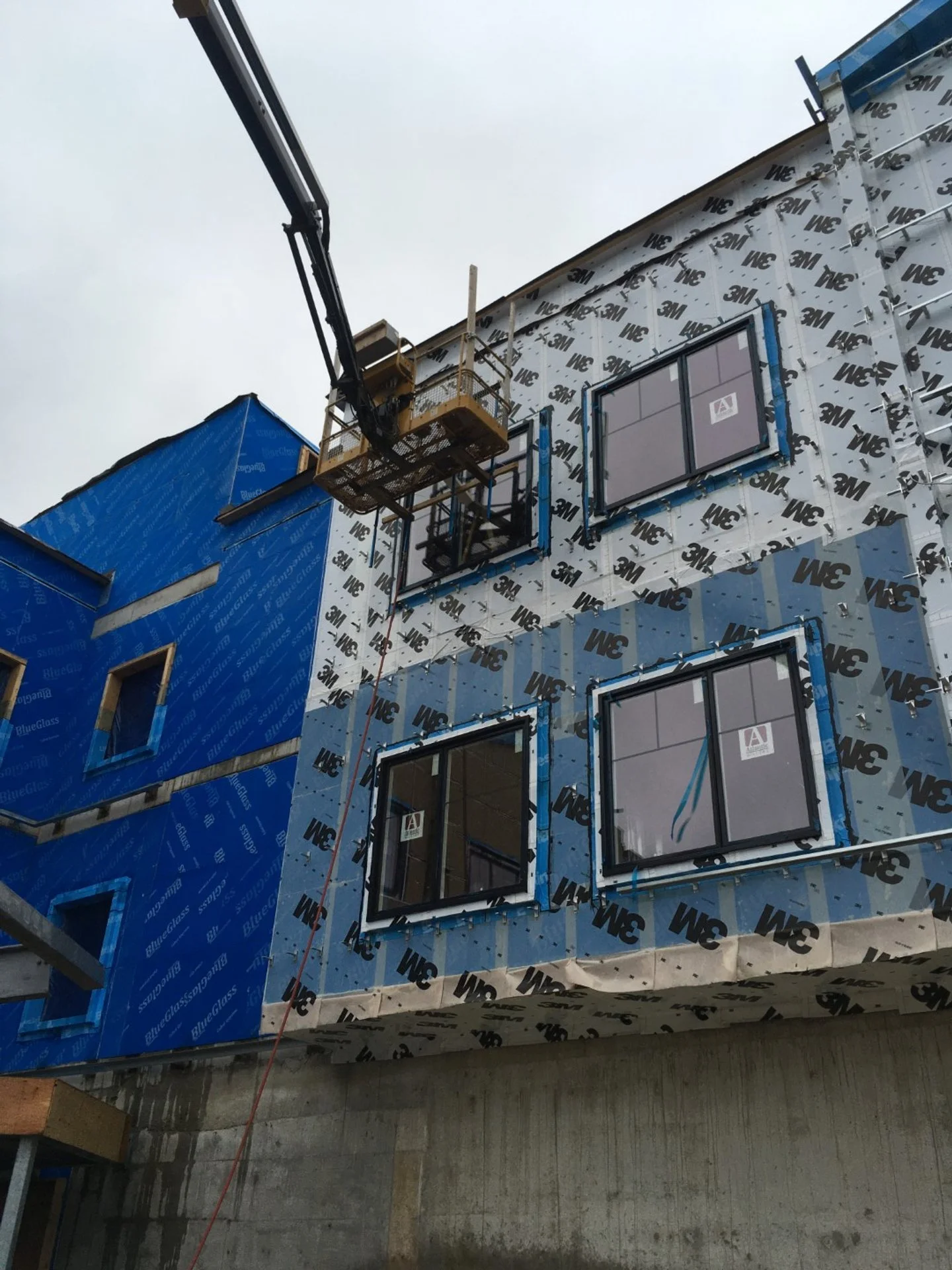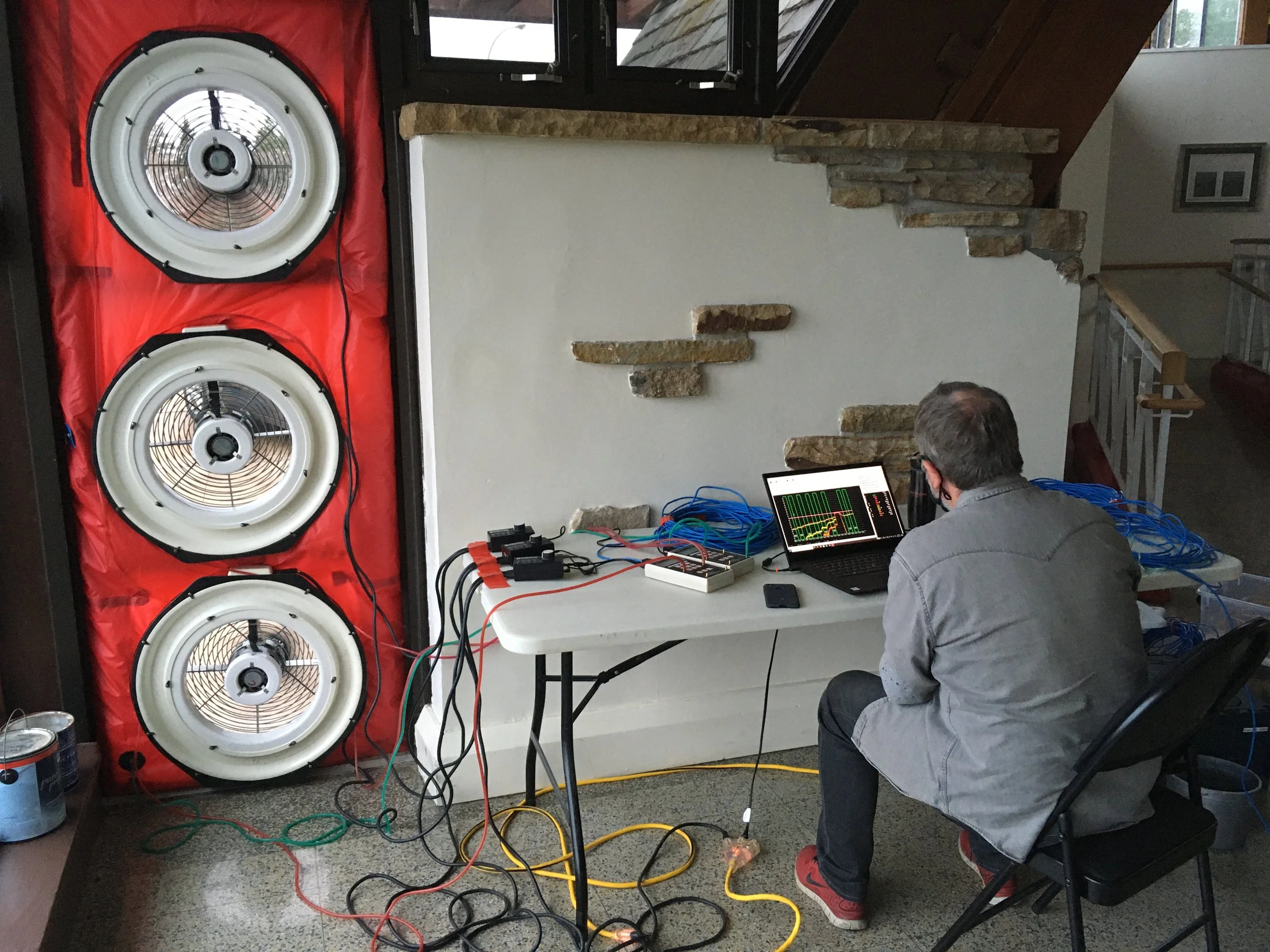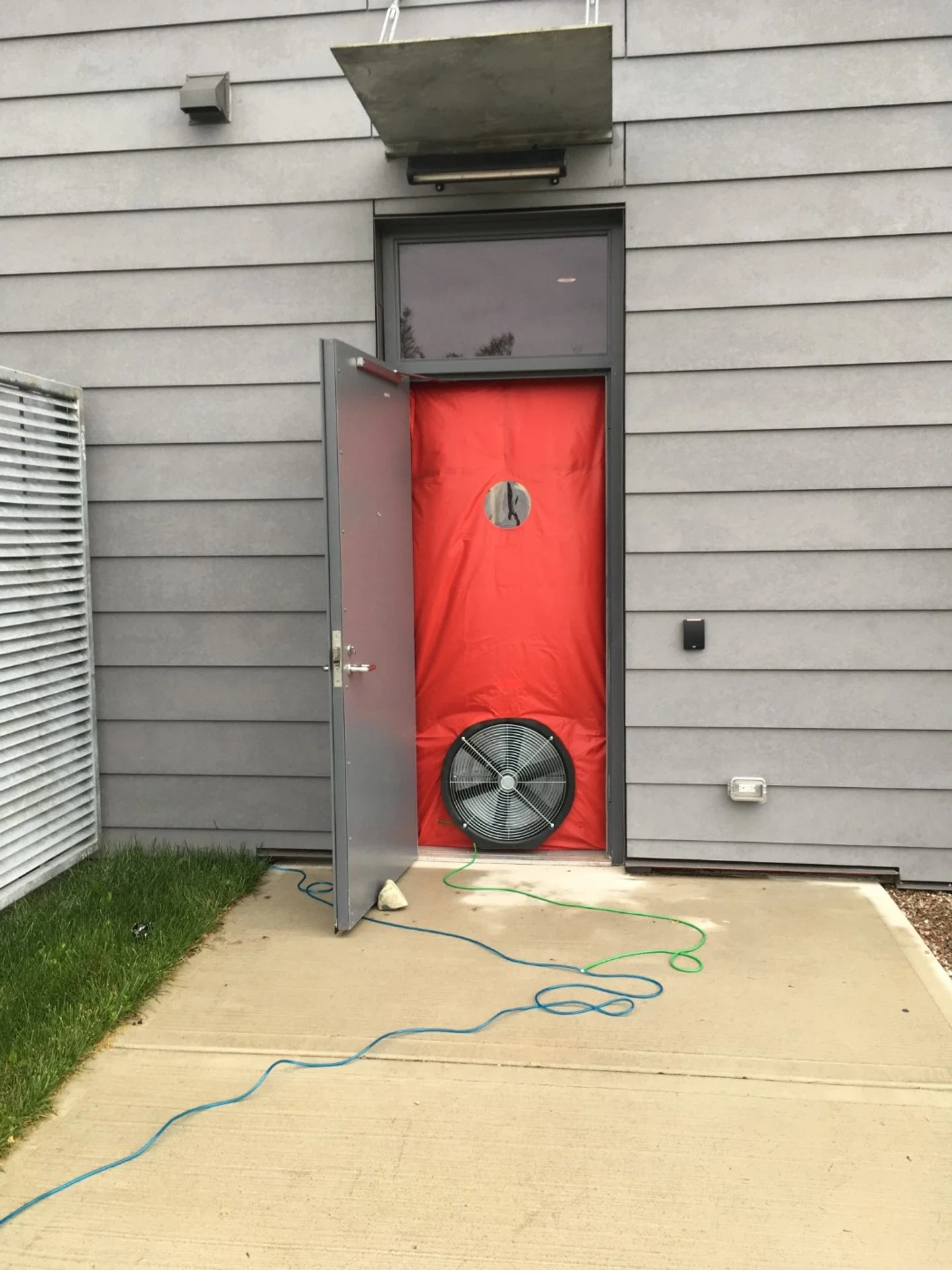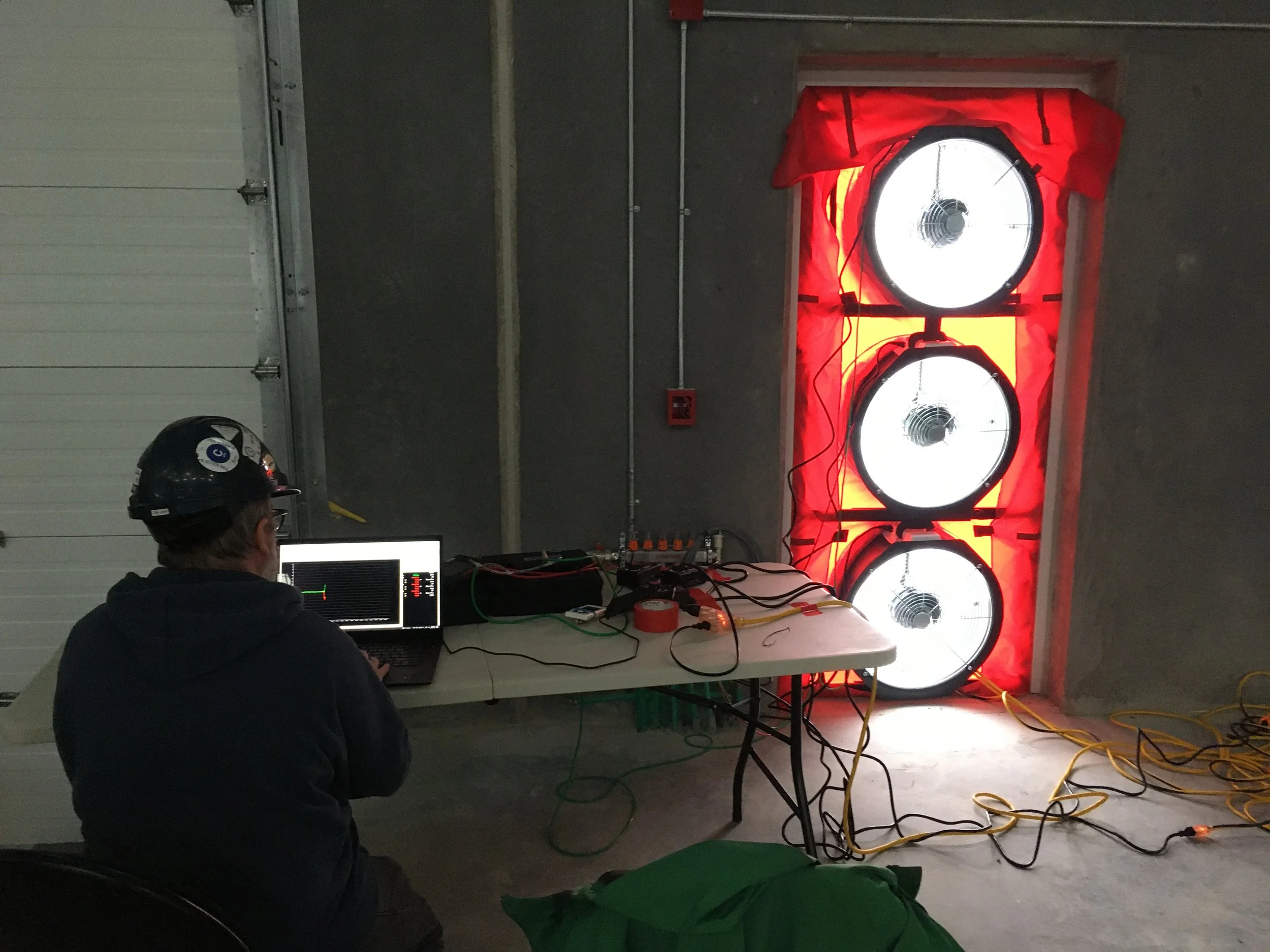You can build better.
Building Performance
You’re transforming the built environment in Atlantic Canada. We’re here to help.
We work with institutional and commercial clients through any stage in the lifecycle of a building. We strive to simplify smart building decisions, improve occupant well-being, and drive long-term value for stakeholders.
By providing expert guidance, dependable information, and forward-thinking advocacy, we help create durable, healthy environments that support business success and environmental responsibility.
BUILDING PERFORMANCE TESTING SERVICES
Window and Curtain Wall Testing
ThermalWise acts as a third-party testing agency specializing in window, door, and curtain wall performance testing. Using ASTM, AAMA and CSA standardized procedures, we assess both air leakage and water penetration to verify how building enclosure components perform in real-world conditions. In this way we can confirm performance and help identify problems before they become costly.
Why do window and curtain wall testing?
Both air leakage and water entry can have serious consequences for a building’s durability, comfort, and operating costs.
Air testing helps identify unwanted drafts and leakage paths that compromise energy efficiency, indoor comfort, and HVAC performance. Over time, uncontrolled air movement can also contribute to condensation issues within wall assemblies.
Water testing ensures that fenestration and curtain wall systems are effectively keeping out moisture, protecting structural elements from damage and reducing the risk of mold or rot.
Testing provides clarity: it verifies that new installations meet specified performance targets, and it can also serve as a diagnostic tool to pinpoint the source of leaks or failures in existing assemblies.
How it works
Water penetration testing simulates rainfall by applying water to the exterior of the window or curtain wall with a calibrated spray rack. The interior side is chamber-sealed to reveal and document any leakage.
Air leakage testing uses pressure differentials to measure how much air passes through the installed system. In addition to quantifying leakage, site detection methods can identify specific areas where sealing is weak.
Standards We Follow
ThermalWise conducts testing in accordance with industry-recognized standards, including:
ASTM E1105 – Field Determination of Water Penetration of Installed Ext. Windows, Skylights, Doors, Curtain Walls, and Wall Assemblies
ASTM E783 – Field Measurement of Air Leakage Through Installed Exterior Windows
ASTM E779 - Determining Air Leakage Rate by Fan Pressurization
ASTM E1186 – Air Leakage Site Detection in Building Envelopes and Air Barrier Systems
ASTM E2128 - Evaluating Water Leakage of Building Walls
CSA A440.4-07 – Window, Door, and Skylight Installation: Appendix D, Field testing of window and door installations
CAN/CGSB 149.10 - Determination of the airtightness of building envelopes by the fan depressurization method
AAMA 501.1 - Water Penetration of Windows, Curtain Walls and Doors Using Dynamic Pressure
AAMA 501.2 - Water Leakage Field Check of Installed Storefronts, Curtain Walls, and Sloped Glazing Systems
AAMA 501.3 - Field Check of Water Penetration Through Installed Ext. Windows, Curtain Walls, and Doors by Uniform Air Pressure Diff.
Whole Building Air Leakage Testing
ThermalWise acts as a third-party independent testing agency specializing in the airtightness performance of building enclosures. Using ASTM and USACE standardized procedures, we quantify and report air leakage for components, assemblies, and whole building systems.
Why do air leakage testing?
Preventing uncontrolled air leakage is essential for both energy efficiency and building durability.
Energy efficiency: Leaky enclosures increase heating and cooling costs and strain HVAC systems.
Comfort: Drafts and uneven temperatures affect occupant satisfaction.
Durability: Air leakage can carry moisture into wall assemblies, leading to condensation, mold, or structural damage.
By setting airtightness performance targets and testing against them, owners can verify quality during construction or diagnose weaknesses in existing buildings.
How it works
Airtightness testing is carried out using large fans to create controlled pressure differences across the building enclosure.
This allows us to:
Measure leakage rates and compare them to performance standards.
Detect leakage paths with diagnostic tools, so air sealing improvements can be targeted effectively.
Standards We Follow
ThermalWise conducts airtightness testing in accordance with:
ASTM E779 – Determining air leakage rate by fan pressurization
ASTM E1186 – Air Leakage Site Detection in Building Envelopes and Air Barrier Systems
ASTM E3158 – Measuring air leakage rate of large or multizone buildings
U.S. Army Corps of Engineers – Air Leakage Test Protocol for Building Envelopes
Thermal Imaging
Thermal imaging is an advanced diagnostic tool used to assess building enclosure performance. By detecting variations in surface temperatures, it provides clear insight into the continuity and effectiveness of air, thermal, and water barrier systems. Offered as a stand-alone service or in conjunction with other assessments, thermal imaging helps identify air leakage pathways, insulation deficiencies, and potential sources of moisture intrusion—critical factors in ensuring long-term building durability and performance.
Early Detection - Locate deficiencies before they develop into costly failures or occupant complaints
Quality Assurance - Verify that insulation and air/water barrier systems have been installed to specification
Risk Mitigation - Reduce the potential for moisture damage and energy loss while increasing occupant comford
Performance Validation - Provide documentation that building enclosures are meeting design intent and performance standards.
Why conduct thermal imaging?
How it works
Thermal imaging employs infrared technology to measure and display surface temperature differences across the building enclosure. Areas of abnormal heat loss or gain indicate potential air leakage, missing or compromised insulation, or moisture accumulation. When integrated with methods such as blower door testing, thermal imaging delivers a precise evaluation of enclosure performance, allowing for targeted remediation and improved building efficiency.
Standards We Follow
ThermalWise conducts testing in accordance with industry-recognized standards, including:
ASTM C1060 – Thermographic Inspection of Insulation Installations in Envelope Cavities of Frame Buildings
ASTM E1186 – Air Leakage Site Detection in Building Envelopes and Air Barrier Systems
ASTM C1153 – Location of Wet Insulation in Roofing Systems Using Infrared Imaging
Additional Building Envelope Testing Services
ASTM C1521-19 - Sealant Adhesion Testing
This standard lays out both destructive and non-destructive field methods for checking how well weatherproofing sealant joints are holding up. Rather than testing the sealant's ability to keep out weather, it focuses on the strength of the adhesive bond itself—ensuring it's properly adhered to its substrate.
The destructive method deliberately stresses the sealant until it fails—either cohesively (within the sealant) or adhesively (at the bond with the substrate)—to evaluate how it performs under strain.
The non-destructive procedure applies strain without causing a full failure, making it valuable for inspecting large sections or entire sealant runs while maintaining the installation intact.
This makes ASTM C1521-19 a powerful tool for identifying weak adhesion in sealant applications and guiding timely repairs or improvements.
Ventilation Testing
This service includes measuring and adjusting the total supply and exhaust air flows of whole systems, measuring and adjusting individual exhaust and supply diffuser flow rates, measuring room-by-room pressure differences, and ensuring that design values are being met. Mechanical ventilation influences both occupant comfort and health. Ventilation systems are also an electrical load and frequently have a role in space conditioning. Efficient and optimal operation of mechanical ventilation systems is critical for high-performance buildings.

















